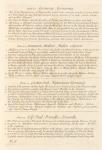1. This is the Eupatorium of Dioscorides, Galen, & the ancient Greeks; it grows about two Foot high, having several winged hairy Leaves of a pale green Colour, and yellow Flowers.
2. It grows in Hedges, and the Borders of Fields, and flowers in Iune and Iuly.
3. Agrimony is esteemed cleansing and purifying for the Blood, strengthening ye Liver, and good in all Diseases arising from the Weakness thereof, as the Dropsy, Jaundice &c. Matthiolus recommends it with white Wine as an excellent cure for the Strangury and bloody Water. Riverius extols ye Powder of ye dried Leaves for the Incontinence of Urine. It is likewise a vulnerary Plant, & put in Wound-Drinks; & outwardly used in Baths & Fomentations.
4. Greek, Ευπατώριον. Latin, Agrimonia, or Eupatorium Graecorum. Spanish, Agramonia. Italian, Agrimonia. French, Agremoine. German, Adermeng. Dutch, Agremonie.

 22. Common Mallow. Malva vulgaris.
22. Common Mallow. Malva vulgaris.
Also see #054, Hollyhocks.
1. Mallows grow to be three Foot high; the Stalks are somewhat hairy, & the Leaves are a yellowish Green, ye Flowers are a bright reddish Purple, strip'd with a deep Purple.
2. It grows commonly by Way-sides, and flowers for most Months in the Summer.
3. This is one of the five emollient Herbs, being Loosening, Cooling & Molifying. A Decoction of the Leaves, sweetned with Syrup of Violets, & drank now and then to the Quantity of a Quarter of a Pint, keeps the Body soluble, asswages choleric Humours, allays the heat & sharpness of Urine, eases the Stone & Gravel, and provokes Urine. A Cataplasm made of the Leaves, eases the smart of the Place that is stung by Bees or Wasps. Where Marsh Mallows are not to be had this may supply the Place.
4. Greek, Μαλάχη. Latin, Malva & Malva vulgaris, or agrestis. Spanish, Malvas. Italian, Malba, or Malva. French, Malve. German, Pappel. Dutch, Kaassescruyd.

 23. Garden Cress. Nasturtium Hortense.
23. Garden Cress. Nasturtium Hortense.
Also see #023, Cress. - #120, Buckshorn.
1. It grows to be eighteen Inches high; the Leaves are a bright Green, & the Flowers white.
2. It is sown in Gardens yearly, and flowers most Months in the Summer.
3. The Leaves are much used as a Sallad, their warmth being good to help the coldness of others mixed with them. They are esteemed good for the Scurvy, Dropsy, Palsy and Lethargy. A Cataplasm of the Leaves with Hog's Lard cures scald Heads, the Seed helps the Scurvy and Dropsy, and swelling of the Spleen; and opens Obstructions in the Female sex, and prevents the falling off of the Hair.
4. Greek, Κάρδαμον. Latin, Nasturtium. Spanish, Nasturtio, and Malpica. Italian, Nastrutio and Agretto. French, Cresson de Jardini, and Nasitort. German, Gartencress. Dutch, Thuyn-Kersse.

 24. Self-Heal. Prunella or Brunella.
24. Self-Heal. Prunella or Brunella.
1. This Plant grows to be a Foot high, the Leaves are a dark Green, and the Flowers Purple.
2. It grows in Meadows and pasture Grounds, flowering all the latter Months of the Summer.
3. It is used for all Inflammations and Ulcers in the Tongue, Jaws and Throat, either the Juice or a strong Decoction, as also for inward Bleedings & making of Bloody Water.
4. Greek, Ευπατώριον. Latin, Prunella or Prunella vulgaris. Spanish, Agramonia. Italian, Consolida minore. French, Agremoine. German, Brunellen, & Adermenge. Dutch, Bruynelle. (Henriette's comment: I think she's mixed in some names of Agrimony here. See #21, Agrimony.)




